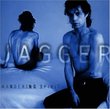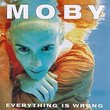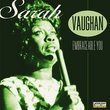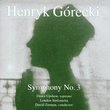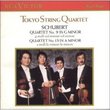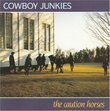| All Artists: Franz [Vienna] Schubert, Academy of St. Martin-in-the-Fields Chamber Ensemble Title: Schubert: Octet in F major, D. 803 Members Wishing: 0 Total Copies: 0 Label: Chandos Release Date: 10/28/1992 Genre: Classical Styles: Chamber Music, Historical Periods, Classical (c.1770-1830) Number of Discs: 1 SwapaCD Credits: 1 UPCs: 095115858523, 5014682858526 |
Search - Franz [Vienna] Schubert, Academy of St. Martin-in-the-Fields Chamber Ensemble :: Schubert: Octet in F major, D. 803
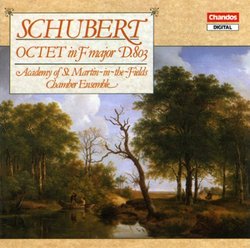 | Franz [Vienna] Schubert, Academy of St. Martin-in-the-Fields Chamber Ensemble Schubert: Octet in F major, D. 803 Genre: Classical
|
Larger Image |
CD DetailsSimilarly Requested CDs
|
CD ReviewsThe Academy's second and not so successful go at Schubert's Discophage | France | 12/09/2006 (3 out of 5 stars) "The Academy of Saint-Martin-in-the Fields Chamber Ensemble had already made an outstanding recording of Schubert's Octet in 1977 for Philips (see my review under the original CD reissue, Octet, D.803. It is now available on a twofer from the budget-priced Duo series with the Beaux-Arts trio's "Trout" and the Quartetto Italiano's "Death & the Maiden": Schubert: Great Chamber Works), but this new one, made ten years later around 1st violin Kenneth Sillito, shares only three of the members involved back then: viola, cello and horn. Recorded and released hard on the heels of the version published by DG with Gidon Kremer and partners (Schubert: Octet D 803, see my review), it was generally enthusiastically received by the critics - and I don't entirely agree.
Part of the problem lies with the resonant church acoustics (it was recorded in St Silas Church, London). It deprives the instrumental definition of some clarity, and the horn and clarinet seem picked up from a greater distance than the strings. In the 3rd movement (a Scherzo in all but name) you might even think that there are two horns involved. As a result perhaps, tempos are generally spacious, to the point sometimes of ponderousness. Witness the opening movement. Tempo (including that of the slow introduction) is spacious and acoustics are resonant. The music gains in symphonic grandeur but, despite the Academy members' creamy instrumental tone and laudable effort to animate the movement and give it dramatic impact, it does loose a touch in sprightly liveliness and sounds a bit heavy-footed, like a Beethoven symphony played by a traditional symphony orchestra rather than a sinewy, period instrument ensemble: the leaner and more dynamic approach of the 1977 Academy was more convincing and dynamic. Like their predecessors but unlike the contemporary Kremer on DG, the Chandos Academy does not take the first movement repeat, an unfortunate decision not justified by the CD's time limitation as it had been by the LPs. They also slam the breaks at 7:20 upon the return of the opening theme double note value (quarter note becomes half note), in order to harmonize tempo with the one they had adopted in the intro - but the slowing down is uncalled for by Schubert, and only seems to point to the players' apparent misjudgment of Schubert's tempo relationship. Likewise the second movement "adagio" is spaciously paced and quite beautiful, but the cost is a touch of rhythmic laziness. The conception is close to the Academy's 1977 essay, though a little more animated in the more dramatic passage starting at 7:21. Andrew Marriner (also featured on a recording made a few months earlier but released a little later with the Chilingirian Quartet on the British mid-price EMI Eminence) produces beautifully hushed and dreamy clarinet pianissimos, and in general instrumental tone is more luscious in 1987 than in 1977 (try the cello cantilena at 6:24), but as mentioned clarinet and horn seem recorded from a further distance than the strings, and the effect is somewhat artificial. Again spacious tempo, resonant acoustics and a distant sounding horn rob the third movement "Allegro vivace" of some of its impact - but the bassoon registers clearly. In the fourth movement (a theme and variations), the theme's enunciation doesn't linger but isn't as zestful as Kremer and partners (DG). Tempo is relaxed in the ensuing variations, with the second played with bonhomie rather than with the rhythmic bite and dramatic impact imparted to it by Kremer and his Lockenhaus partners. Yet the ASMF members do not hesitate to dramatically vary tempo in order to characterize different moods, as in the "slow" fourth variation to which they bring a wistful quality, and the "fast", tango-like fifth variation. 1st fiddler Kenneth Sillito's purity of tone is a remarkable feature in his variation 3 and 7 filigree, but Denis Vigay's cello accompaniment is hardly audible against the brass and woodwinds in the latter. The Menuetto (5th movement) is relaxed and not strongly accented (compare its 7:36 duration to Kremer's 6:34), and again the effect of this "gemütlich" approach I find pedestrian and ultimately soporific, despite some fine dynamic nuancing by Sillito. On the other hand, after again a spacious intro which sounds like the accompanied recitative of an opera, the finale is commendably brisk and sprightly but once again the resonant acoustics deprive it of some instrumental definition, making it sound busy but slightly untidy. This is a version for those who prefer their Schubert symphonies played by Furtwängler or Böhm than by Fricsay or Szell. But the Academy's first essay is preferable, and for those who insist on digital versions, among versions recorded at the same time as this Chandos disc, Kremer's recording is preferable despite its misconceived and plodding Finale, and the Berliner Octet's on Teldec is better still (see my review of Schubert Octet in F Major Berliner Solisten). " |

 Track Listings (6) - Disc #1
Track Listings (6) - Disc #1